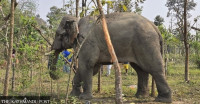Sudurpaschim Province
Census shows increase in tiger population in Shuklaphanta after four years
The national census of tigers conducted in 2018 had put the number of adult big cats in Shuklaphanta at 16.
Bhawani Bhatta
The number of tigers has increased in Shuklaphanta National Park, according to the recent count conducted by the park.
On Friday, officials of Shuklaphanta National Park released the latest tiger census highlighting the increase of the tiger population in the park.
According to the census carried out between May 18 to June 6 this year, 19 adult tigers including six males, 11 females and one, whose gender is yet to be determined, were recorded in the park.
The national census of tigers conducted in 2018 had put the number of adult big cats in Shuklaphanta at 16.
According to the park officials, the tiger count was conducted using the camera trapping method.
“The park area was divided into 89 grids and a couple of automated cameras were installed in each of the grids to record the movement of tigers for at least 15 days,” said Dil Bahadur Purja Pun, chief conservation officer of the park.
According to Pun, the increase in the number of tigers may not seem high but it is encouraging news.
“In Shuklaphanta, the tiger's population had not changed for a long time. That’s why even this slight change in tiger numbers bears a great significance,” said Pun.
The census also found that the ratio of male and female tigers is also almost equal.
“In the past, the male-female tiger ratio was lopsided. But now the number of males and females complement the entire tiger population in the park,” said Pun.
Tiger census was carried out with the technical assistance of the National Trust for Nature Conservation and Zoological Society of London. Thirty-three technicians were deployed in the tiger count.
“We had selected a proper time frame to count tigers. The movement of tigers was frequent in particular locations this monsoon so it made it easier for us to not miss any tigers,” said Laxmiraj Joshi, chief at Shuklaphanta Conservation Programme of the National Trust for Nature Conservation.
Shuklaphanta is a suitable location for tigers with the availability of prey and habitat. According to 2018’s census, over 68 wild animals (prey) were found per square kilometres inside the park.
Once upon a time, Shuklaphanta was known as one of the major habitats of tigers in Asia. In 2002, there were 26 adult tigers in the park. Since then, the number of tigers decreased gradually in Shuklaphanta, the record of the park showed.
In 2008, eight tigers were recorded in the park and the number of tigers increased up to 17 in 2013, according to the data of Shuklaphanta National Park.
According to conservationists, there’s a challenge in tiger conservation due to rapid human encroachment near Shuklaphanta National Park and buffer zone areas. With the increase in tiger population, big cats are seen straying outside their habitats and getting closer to human settlements, resulting in conflicts with communities.
In Nepal, tigers are mainly found in its five protected areas and adjoining forest areas outside the protected parks in the low-lying Tarai belts.
The Nationwide Tiger and Prey Survey 2018 recorded an impressive 19 percent increase in tiger numbers from the 2013 estimate of 198 tigers to 235.




 18.12°C Kathmandu
18.12°C Kathmandu












